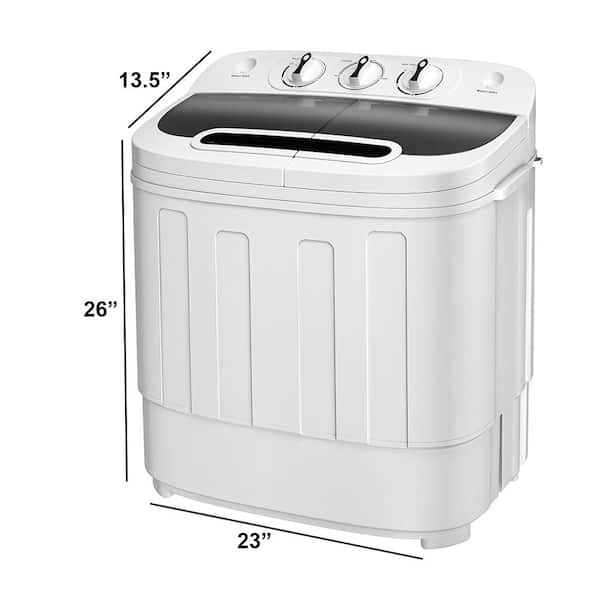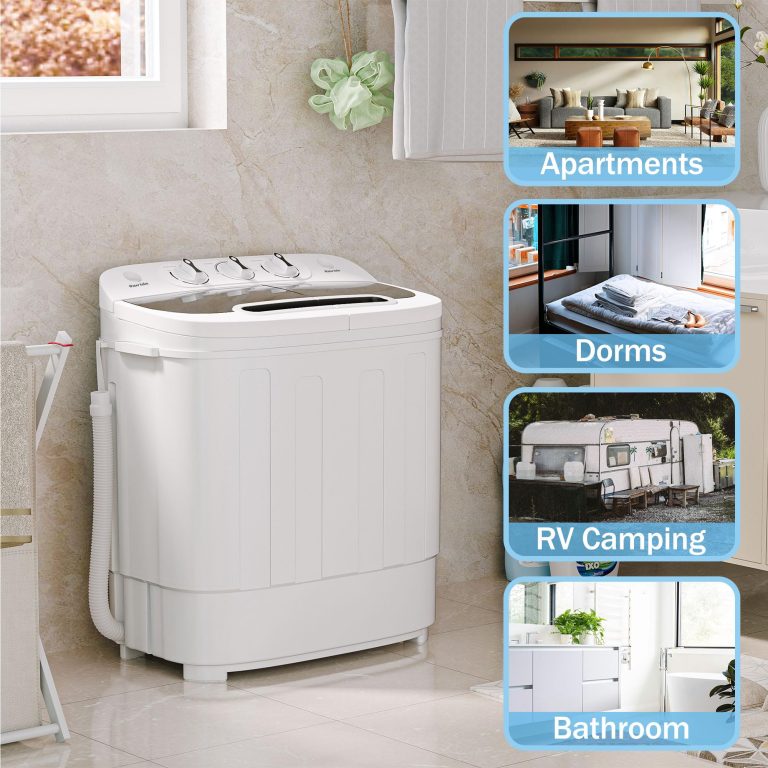Are you struggling with draining your portable washer in a cramped apartment or a tiny laundry nook? When space is limited, even the simplest tasks can become a headache.
You might feel frustrated as you try to figure out how to efficiently manage your laundry without making a mess. Imagine the relief of knowing exactly what to do, effortlessly draining your portable washer without any spills or stress. This guide is here to transform your laundry routine, offering practical tips and tricks to help you drain your portable washer easily, even in the smallest of spaces.
Let’s dive into the solutions that will make your laundry day a breeze, giving you more time to enjoy your cozy home.

Credit: www.amazon.com
Choosing The Right Portable Washer
Choosing the right portable washer is crucial, especially when you’re working with limited space. Whether you live in a cozy apartment or a compact RV, the right washer can make laundry day a breeze instead of a chore. But how do you pick the perfect one? Let’s dive into what you need to consider to make the best choice.
Size And Capacity Considerations
When space is tight, size matters. You want a portable washer that fits comfortably in your designated area without overwhelming it. Measure the space where you plan to place the washer and compare it with the dimensions of various models.
Capacity is equally important. Think about the size of your typical laundry load. A washer that’s too small means more frequent loads, while one that’s too large may be a waste of space. Assess your needs and balance them with the available space.
Consider how often you wash heavy items like towels or jeans. A larger capacity might be necessary for heavier loads, even if you’re short on space.
Features For Small Spaces
Modern portable washers come with features designed for small spaces. Look for models with wheels or handles for easy mobility. You can tuck them away when not in use, maximizing your living space.
Some models offer foldable lids or collapsible components. These can be lifesavers in cramped quarters, allowing you to store them more efficiently.
Another feature to consider is noise level. In small spaces, a loud washer can be disruptive. Check reviews and specifications to find a model that runs quietly.
Before you make your purchase, think about your specific living situation. Do you need a washer that can adapt to different areas? Will you benefit from extra portability or quiet operation? These questions can guide you to the perfect choice.
By focusing on size, capacity, and features tailored for small spaces, you can find a portable washer that suits your lifestyle. Have you ever bought an appliance that was too big or too loud? Share your experiences and learn from them to make a better choice next time.
Setting Up Your Portable Washer
Setting up a portable washer in a small space can seem tricky. With the right approach, it’s simple and efficient. You’ll need to consider key factors like placement and water supply connection. Each plays a vital role in your washer’s performance.
Placement Options
Consider the available space in your home. The washer should fit comfortably without blocking pathways. Kitchens, bathrooms, or laundry areas work best. Ensure there is a nearby power outlet. A stable surface prevents vibrations during wash cycles. Avoid placing the washer on carpets. Hard floors like tiles or wood are ideal.
Water Supply Connection
Connecting the water supply is crucial. Identify the nearest faucet. Portable washers often come with a faucet adapter. It allows easy attachment to your tap. Ensure a tight fit to prevent leaks. Use a wrench if needed. Turn on the faucet to check the connection. Water should flow smoothly into the machine. If not, recheck the connections and adjust as needed.
Draining Methods For Small Spaces
Living in a small space presents challenges. Draining a portable washer is one. Limited space makes it tricky. You need efficient draining methods. Below are two methods suited for small spaces.
Gravity Drain Method
The gravity drain method is simple. It uses natural gravity to empty water. Place the washer on an elevated surface. A sturdy table or platform works well. Ensure the drain hose hangs lower than the washer. This lets water flow out naturally. This method requires minimal setup. It’s cost-effective and easy to do.
Pump-assist Drain Method
The pump-assist drain method uses a small pump. This pump helps move water out. It’s ideal for spaces with no height options. Attach the pump to the washer’s drain hose. Plug it into a power source. This method is efficient and reliable. Pumps can be found in most hardware stores. It’s a great choice for tight spaces.

Credit: www.homedepot.com
Tools And Accessories For Efficient Drainage
Efficient drainage tools make using portable washers in tight spaces easier. Compact hoses fit in small areas, directing water smoothly. Accessories like quick-connect adapters help attach hoses securely, ensuring a mess-free operation.
Draining a portable washer in a small space can be a bit tricky, but having the right tools and accessories can make the process much easier. Whether you’re dealing with a cramped apartment or a tiny laundry corner, efficient drainage is essential. With the correct hoses, connectors, and containers, you can ensure that water is channeled properly and safely without making a mess. Let’s dive into the essentials you need to tackle this task with ease.Hoses And Connectors
A reliable hose is the backbone of your drainage setup. Look for a durable, flexible hose that easily attaches to your washer. Make sure it’s long enough to reach your designated drainage area without stretching or pulling. Consider using a hose with multiple connectors. This gives you the flexibility to attach it to different water outlets or drainage points. Quick-connect fittings are particularly helpful for fast setup and removal. Remember, a secure connection prevents leaks. Always check the tightness and compatibility of your connectors. If you’ve ever had a hose pop off mid-drain, you know it’s a mess worth avoiding.Drainage Containers
Selecting the right container for water collection is crucial. A sturdy bucket or basin can effectively catch and hold water. Ensure it has enough capacity to avoid frequent emptying during a single wash cycle. Space-saving containers are perfect for small areas. Look for collapsible or stackable options that can be stored easily when not in use. These are lifesavers in a tiny apartment or laundry nook. Always position the container at a lower level than the washer. Gravity will help guide the water into the container, reducing the risk of overflow. Have you ever thought about using a small dolly to easily move heavy, water-filled containers? By considering these tools and accessories, you can enhance your portable washer experience. What other tools do you find indispensable for your laundry needs in small spaces?Maintenance Tips
Maintaining a portable washer in small spaces can be challenging. Regular upkeep ensures your appliance runs smoothly. Here are some effective maintenance tips to keep your washer in top shape. These steps will help prolong its life and efficiency.
Cleaning The Drain System
Cleaning the drain system is essential for preventing clogs. Begin by unplugging the washer. Locate the drain hose and remove it. Check for any debris or build-up inside the hose. Use a small brush or cloth to clean the hose thoroughly. Reattach the hose securely after cleaning.
Inspect the drain filter regularly. Remove any lint or particles trapped inside. A clean filter ensures proper water flow. This prevents overflow and potential damage to your washer.
Routine Checks
Routine checks help identify issues before they become major problems. Examine the hoses for any signs of wear or leaks. Replace damaged hoses promptly to avoid water damage.
Test the water level sensor regularly. Ensure it accurately measures water levels. A faulty sensor can lead to inefficient washing and potential flooding.
Check the washer’s balance during operation. An unbalanced washer can cause excessive vibration. Adjust the load to maintain stability and prevent damage.
Perform these checks monthly. Keeping a regular schedule minimizes wear and tear. It ensures your portable washer remains reliable and efficient.

Credit: www.homedepot.com
Troubleshooting Common Drainage Issues
Finding space to drain a portable washer can be tricky in small areas. Consider using a sink or bathtub for drainage. Ensure hoses are securely fastened to prevent leaks and spills.
Dealing with drainage issues in portable washers can be a bit tricky, especially in small spaces. You’ve probably experienced a sudden puddle of water or the frustration of waiting forever for water to drain. These issues can turn laundry day into a real hassle. But don’t worry! With a few simple checks and adjustments, you can solve these common problems and get your washer working smoothly again. ###Leakage Problems
Leakage is a common headache. It often stems from loose connections or damaged hoses. Begin by checking the hose connections. Make sure they are tightly secured to both the washer and the drainage outlet. If you spot any cracks or wear, replacing the hose is a wise move. Another thing to look at is the washer’s door seal. A faulty seal can cause water to escape. You can inspect it by running your fingers around the seal for any gaps or tears. Cleaning it from any lint or residue can also prevent leaks. ###Slow Drainage Solutions
A slow-draining washer can be very annoying. This issue might be due to a clogged drain hose. Detach the hose and check for any blockages. A simple rinse can often clear out any debris stuck inside. If the hose is clear, consider the height of the drainage outlet. A hose positioned too high can slow down the water flow. Adjust it to an appropriate level to ensure smooth drainage. Sometimes, the problem might lie in the washer’s filter. A clogged filter can restrict water flow. Clean the filter regularly to prevent this issue. Remember, a little maintenance goes a long way in preventing drainage problems. Have you ever faced these issues with your portable washer? How did you tackle them? Share your experiences or tips in the comments below!Frequently Asked Questions
Where Do You Drain A Portable Washing Machine?
Drain a portable washing machine into a nearby sink or bathtub. Connect the drain hose securely to avoid spills. Ensure the sink or tub is capable of handling the water flow. Regularly check for any blockages in the drain hose for efficient drainage.
How Do You Remove A Washing Machine From A Tight Space?
Disconnect hoses and power supply. Protect floors with blankets. Carefully slide the machine forward, tilting if needed. Use a dolly for easier movement. Ensure you have enough help to lift and navigate.
How Do You Drain A Small Washing Machine?
To drain a small washing machine, unplug it and locate the drain hose. Place the hose in a bucket to catch water. Use a shallow pan to collect remaining water from the filter. Reattach the hose securely after draining.
How To Drain A Washing Machine Without Water Going Everywhere?
Turn off the machine and unplug it. Use a shallow dish or pan to catch water. Slowly remove the drain hose, directing it into the dish. Once drained, securely reattach the hose. Clean up any residual water with towels. Ensure the drain pipe is clear before reconnecting the machine.
Conclusion
Finding ways to drain a portable washer in tight spaces can be challenging. With the right techniques, it becomes manageable and stress-free. Always ensure your setup is secure and clutter-free. Regular maintenance keeps your washer running smoothly. If you follow these tips, you’ll enjoy a hassle-free laundry experience.
Remember, a little effort goes a long way. Keep your space organized and your washer in good condition. Happy washing!


